
When you’re improving your home’s appearance or systems in any way, it becomes an excellent time to make healthy improvements. By planning ahead, you can actually improve the indoor air quality at home through simple choices. The great thing is that often times choosing an eco-friendly or green building material won’t increase your project budget.
It simply takes research and a little bit of knowledge about the materials you’ll be purchasing. If you’re going to be remodeling or improving your house anyways, why not take the opportunity to improve the health of your home at the same time?
If you knew that choosing a product or material could support your health and wellness and wouldn’t add more to the budget, I guarantee you’d choose the healthier option. But this can be easier said than done, right? Researching each and every product can feel overwhelming and sometimes you’re so deep into Googling terms that you get turned around in your research. It’s that feeling of overwhelm that I so often talk about that ends up putting a halt on our healthier choices to be made.
Another important factor when it comes to choosing materials is to know HOW to shop and purchase them. By understanding that your home should have fewer toxins and chemicals, less dust and lower humidity, you can make some really great choices at the hardware store.
These are the areas you can find green building material recommendations for your home’s next project:
- Flooring
- Paint
- Drywall
- Insulation
- Stains & Clearcoats
- Doors and Trim
- Adhesives & Caulking
FLOORING
When it comes to green building materials, flooring is one of the BIGGEST components. Not only is it usually a relatively easy project, but it also has one of the biggest impacts on design and health.
The sheer square footage of new materials that are being installed means flooring has a huge impact on the health of our homes. On top of that, MOST flooring that’s present in a home has a number of toxins present. By making a change to your flooring, you can eliminate a large number of toxins in your home with just one project.
Through choosing a healthy flooring material, you can improve your indoor air quality and health of your home very easily. The trick is to find flooring that has as few VOCs as possible while also finding a material that holds very little moisture and dust in the fibers or surface.
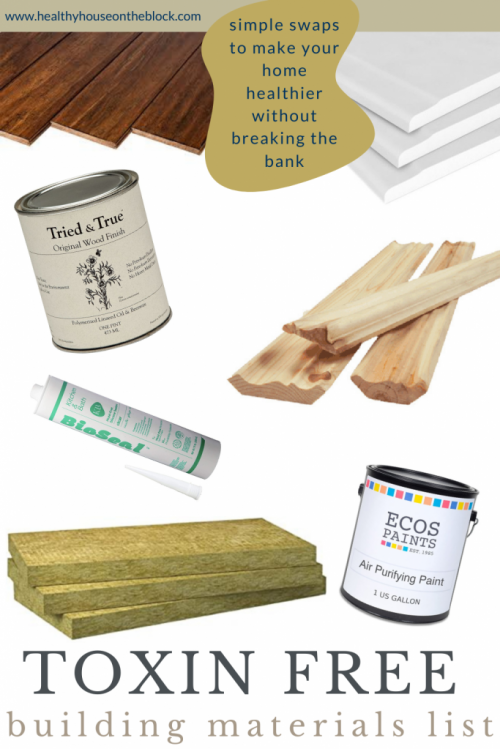
There are many routes you can go with healthy flooring: laminate flooring, toxin free carpet, natural hardwood or natural tile. But each of these green building materials has their own set of challenges when it comes to choosing a healthy, non-toxic version. Finding mateirals that are free from:
- Formaldehyde (carcinogen)
- Polyvinyl Acetate (hormone disruptor, neurological toxicity)
- PFOAs & PFCs (carcinogen, neurological damage)
- Xyelene (harmful to endocrine system and creates imbalance of free radicals in body)
- Toluene (damage to liver and kidneys)
- Styrene (carcinogen, liver and kidney damage, nervous system damage)
- Flame Retardants (endocrine system disruption, carcinogen, reduced fertility, hyperactivity, reduced IQ)
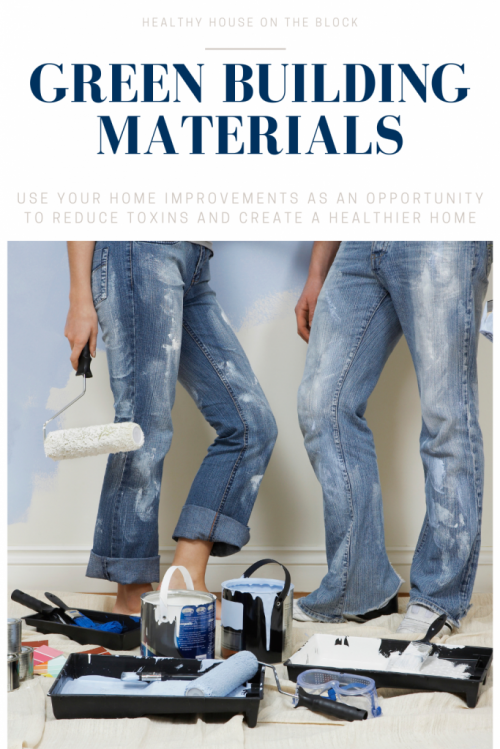
What I find so assuring is that there are more options available now than ever before when it comes to healthy flooring. You can find options for tile, carpet, hardwood and laminate that will keep your space free from as many toxins as possible. These options get a green light from me in terms of green building materials:
- Hardwood: Unfinished Hardwood
- Laminate: CaliBamboo Geowood
- Vinyl: Shaw, Cali Vinyl
- Tile: Stone, Concrete
- Natural Carpet: Nature’s Carpet, Earth Weave
- Synthetic Carpet: Air.O by Mowhawk
- Organic Rugs: Organic Weave Coupon Code: Amanda
Make sure you’re using toxin free adhesives and a dustless install method to ensure your project doesn’t add unnecessary toxins to your space.
DRY WALL
Usually, the only time we get to choose a healthy drywall option is when you’re either building your home or when you do a project that requires new drywall on walls or ceilings. This is SUCH a great opportunity to opt for a green building material that we normally don’t get to change.
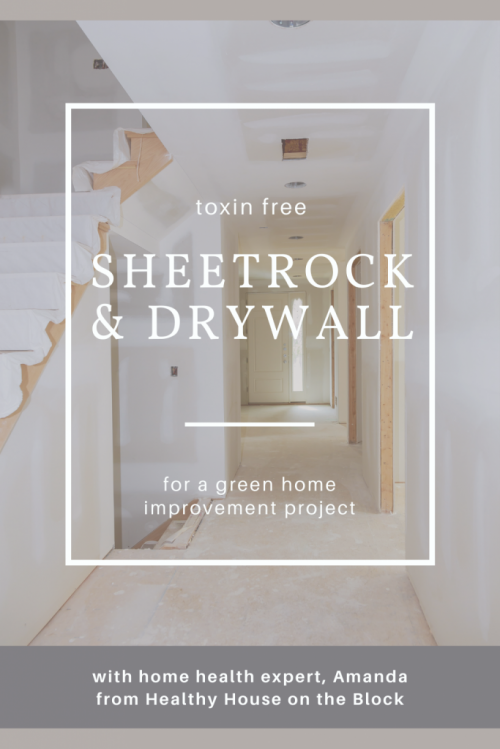
Look for a drywall that has the highest amount of natural gypsum. In the same breath, you’ll want to look for a drywall that has no synthetic gypsum (or the lowest amount of flue gas desulfurization). These synthetic gypsums release large amounts of mercury into the environment during production and are less healthy for your home.
A natural gypsum or magnesium oxide board should be free from biocides (often advertised as mold-resistant). A GreenGuard certified product is another way you can find a healthy option that has no formaldehyde and no acetaldehyde.
If you’re wanting to really up your eco game, opt for magnesium oxide boards, which is ideal for indoor air quality.
Below are some healthier options you can use for installing healthy drywall in your home:
- Gold Bond XP Gypsum Board
- American Gypsum
- Foreverboard
- MgO
PAINT
Painting is another part of a home remodel that can have a huge impact. Bringing in toxic paint can cause big problems with your indoor air quality simply due to the large amount of surface space you’ll be covering.
Download my Toxin Free Paint Guide
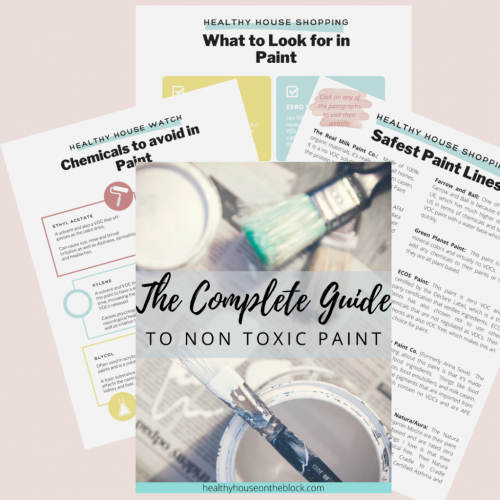
There are SO many great options today that are completely VOC free and are still high-quality paints. You can even purchase paints made of 100% natural materials and dyes.
Paints that are lighter in color generally have fewer VOCS, and paints with a darker, deeper tone produce more VOCs. It’s also a good idea to have fans and open windows during the painting process as the VOC emission is the highest at this time. A really good tip is to look for Green Seal Certified Paints or GreenGuard Certified Paints.
Essentially, you want to make sure that paints are free from APEs (hormone disruption and birth defects), anti-microbials (hormone disruption, child development delays and reproductive harm), colorant VOCs and base VOCs
Below are some brands that have completely VOC free paint options:
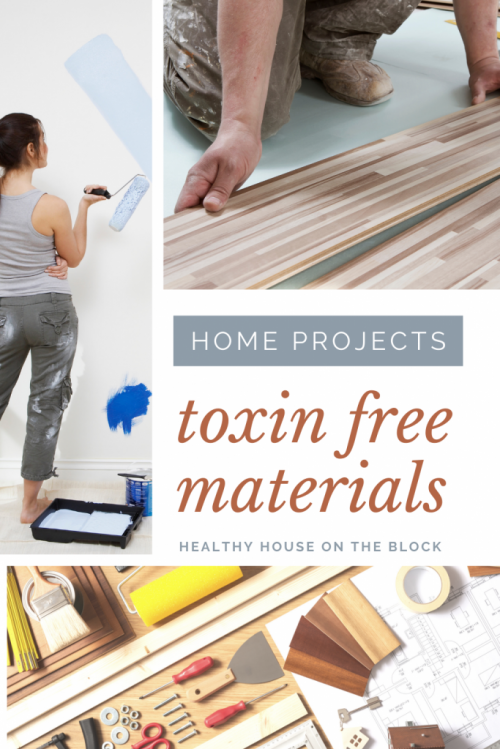
ADHESIVES & CAULK
Caulks and adhesives are quite literally the glue that holds most home projects together. But do we really know what’s in these products? I know I didn’t for a LONG time. The biggest problems with these products it that they contain toxins and VOCs that will continue to off-gas for the length of time it is in your home.
A few ingredients to watch out for are:
- Silica (possible carcinogen)
- Talc (contain asbestos, a known carcinogen)
- Phthalates (hormone disruptor)
- Formaldehyde (carcinogen)
- Styrene (kidney and nervous system damage)
- Biocides (respiratory tract damage)
- BPA (hormone disruptor)
- Ethylene Glycol (kidney toxicity, nervous system damage)
- Isocyanates (known carcinogen)
I wrote an entire post devoted to adhesives and caulks because it’s a question I get ALL the time. These products are ones we use for small home repairs to major renovations and in between.
If you’re looking for safe caulks and adhesives that won’t off gas VOCs into your home and are quick cure/dry to limit odors, these are for you:
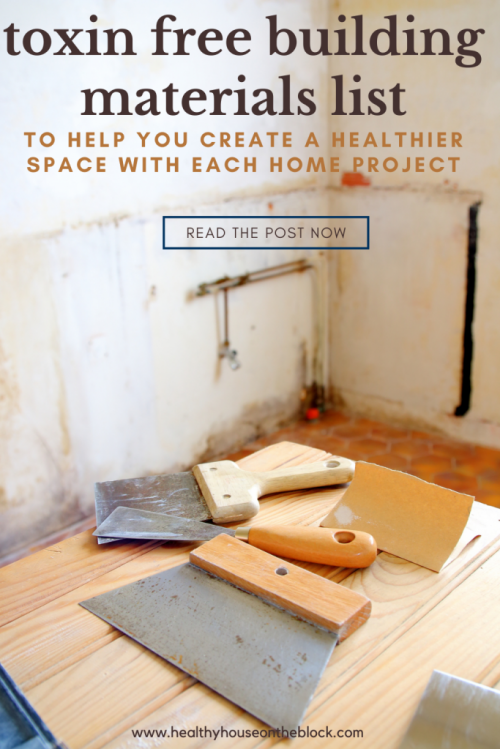
STAINS & CLEARCOATS
Whether you’re staining furniture that goes IN your home or you’re doing some maintenance on wood finishes, stain and clearcoat or sealant is a necessity when owning a home.
The problem with many stains and sealants is that they off-gas for an extremely long time and they have very strong odors when being used.
This post about VOCs will help you understand all of the health issues that can arise from constant exposure to VOCs that are off-gassing. Its important to know that there are many different kinds of VOCs, and many of them have different affects and are used for different products.
A truly green building material product will have either no VOCs or low VOCs. Some of the more well known VOCs to be aware of in stains and clearcoats are:
- Benzene (issues with bone marrow and a known carcinogen)
- Formaldehyde (known carcinogen and causes respiratory issues)
- Methylene Chloride (permanent liver and nerve damage, possible carcinogen)
- Toluene (human carcinogen, damage to central nervous system)
- Xylene (damage to kidneys and liver, human carcinogen)

As like so many green building materials, there are now SO many more VOC free and low VOC options that you can get from hardware stores and online:
INSULATION
If you’re looking to improve the energy efficiency in your house, you may be adding or replacing insulation. Often times attics are a great place to begin adding insulation to improve the thermal barrier of your home.
We recently looked into changing how our basement is insulated in order to prevent additional moisture from coming inside. Adding this element to our walls, I wanted to make sure it was free from the typical toxins (many of which are carcinogenic) that are found in standard insulation:
- Flame Retardants
- Ethanolamine
- Formaldehyde
- Isocyanates
- Polyethylene
- Glycol Ethers
- Styrene
You might initially think that the toxins inside insulation won’t make it to your living spaces because it’s contained behind walls. But the truth is that even during installation, tiny particles will be left behind and parts of the insulation can make it’s way into your HVAC vents and house dust.
I recommend that insulation is third party certified (GreenGuard is a great certification to look for) in order to ensure it’s safe for your interior spaces. These options for insulation are part of the green building materials family:
- Owens Corning EcoTouch
- Knauf EcoRoll/EcoBatt Insulation (GreenGuard Gold Certified)
- Aeroflex Pipe, Duct & Multipurpose Insulation Sheets & Rolls (GreenGuard Gold Certified)
- RockWool Mineral Wool Insulation (GreenGuard Gold Certified)
- Handi-Foam Foam Insulation (GreenGuard Gold Certified)
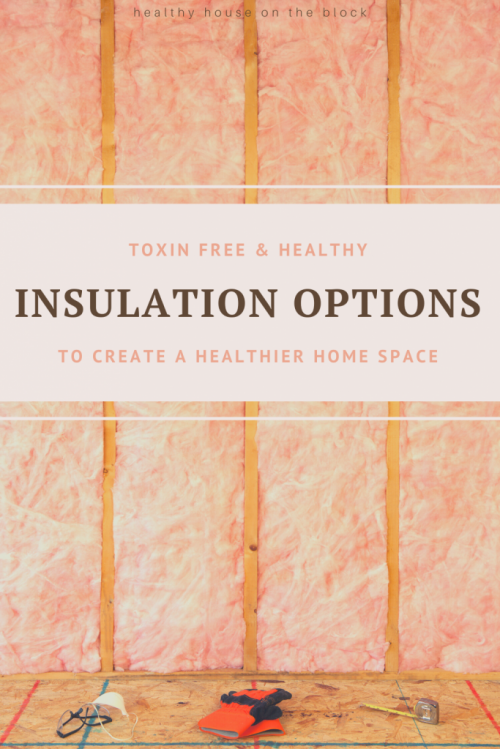
DOORS & TRIM
Doors and trim are another BIG project when it comes to renovating your space. Whether you’re updating one room or the project is to replace all the trim, there are a few ways you can make the process a little healthier for your home.
Green building materials should be as natural as possible, and doors and trim are aligned perfectly with that idea. Make sure you choose solid wood doors and solid wood trim to prevent any sort of product that has toxic adhesives and glues in it.
Some of the worst materials to have instead of solid wood are:
- Plastics
- Medium Density Fiberboard
- Plywood
- Particle Board
- Pressed Woods
- Man Made Laminate Materials
Opt for hardwood that is unfinished and then use one of my recommended sealers and stains to make it look exactly how you want.
It’s also a good idea to cut all trim and woodwork outside and clean it off before bringing it into your living space. This will keep any particles from entering your home’s environment.

Being aware of high quality, green building materials can take your project from just a normal house repair to a health supporting improvement. With these tips, you can affordably create a healthy living space that supports your family’s health and wellness.
Specific Remodel Posts (With all kinds of non-toxic materials and finishes)
Share this:
- Click to share on Facebook (Opens in new window) Facebook
- Click to share on LinkedIn (Opens in new window) LinkedIn
- Click to share on Reddit (Opens in new window) Reddit
- Click to share on Pinterest (Opens in new window) Pinterest
- Click to print (Opens in new window) Print
- Click to share on X (Opens in new window) X




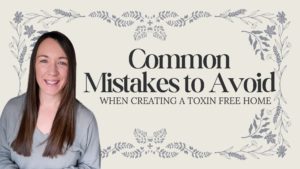

Wow, these are all AWESOME options. I had no idea there were so many green options for my home. Thanks for opening my eyes!
I’m glad this was so helpful! 🙂
This is new to me, I had no idea that a full house can be eco friendly. You just open my mind to build my house with a new perspective, I’ll keep the list of materials to avoid!
I am saving this for the future! My husband and I have a goal to buy property and build our own home in the next 5 years, and we already said we want it as eco-friendly as possible. I hadn’t thought about the actual building materials.
It is important to ensure non-toxic materials are used in the house when renovating. It’s something that needs to be kept an eye on though as workmen don’t always discuss these sorts of these things unless you remember to specify.
Yes, I agree with you! there are a lot of the hidden toxins in everyday building materials and Harmful ingredients can be found in many products.
Thank you, Roseline!
Eco friendly and having healthy materials without toxins is super important to this. will pin this and save for future reference xx
I’m glad you’ll be able to use this info!
I never realized that you can do your entire home eco-friendly. I always try to do eco-friendly with other things such as cleaning products oh, but I never thought to do my entire house like this. at some point, my husband and I are going to buy a house, and I’m definitely going to save this so we know what not to do.
It’s amazing the products they have out there now! We have been slowly replacing things as they wear out with more eco-friendly options instead of all at once.
Oh wow! This is something that I need to do! The tips you’ve mentioned are really amazing and very helpful too. I will keep this in mind.
I need to do some work on the house. I will have to think about this when I am redoing some of the flooring I need to do in the house.
We really use home projects and renovations as a good time to make healthier choices too.
Ooh, what a great post! We will be installing insulation this summer and I will definitely be referring back to your suggestions to help us out!
That’s so great Elaine! I’m so glad it was helpful!
I am in a new community, although, I don’t have the eco-friendly home, I’ve noticed new model eco-friendly homes. I wish this builder was here when I was buying mine.
Most of us don’t live in eco-friendly homes, so you’re not alone! Any small step you do make towards a healthier house is a step in the right direction. 🙂
This is so important! I was very concerned about the building materials used so when we bought our apartment we chose a green project, which was a bit more expensive and smaller but safe!
That is so great, Nati! I love that there are buildings out there focused on health and wellness!
These are things I have never thought about. Thanks for sharing some ideas. I might need to start looking around our house to see if we can do any of these improvements 🙂
You’re welcome, Tiffany! 😊
It’s interesting to know that when any flooring is installed, you want to make sure that non-toxic adhesives are being used. My husband is planning a major remodeling project for my mom’s house, and we are looking for advice. I will let him read this article to help hem to choose the best materials for that project.
I’m glad this was helpful! Let me know if you or your husband have any specific questions, Ellie.
The Sherwin Williams Harmony Paint I think is no longer low odor. Used for years. But having no sense of smell, I bought a gallon and embarked in a winter painting project closed up with what had been previously a safe paint. Much later when my husband came in, he said we have to air this out! It took a long time to outgass. The formula had changed! And I was closely exposed to….what? Never assume anything………
What would be the best eco friendly flooring option for a house with dogs?
Hi Felicia! I think Cali-Bamboo is a great option (especially for pets!). I think it’s more durable, but also free of toxins. They also have some nice color/tone options: https://www.thegreendesigncenter.com/product/cali-bamboo-cork/?ref=4357
Do you happen to know any builders who are familiar with this and will use those non toxic materials to build? (in Los Angeles are)
Hi Eri! Unfortunately, no, I don’t know of any personally. But I bet if you hunt around you could find some who are at least knowledgeable in the space. Often I do consultations with homeowners and buyers to help bridge that gap. 🙂